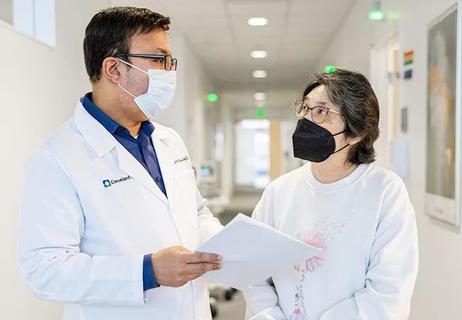Disparities in sociodemographic characteristics, including race, income, health insurance, area of residence and education, may lead to inequities in survival among adolescents and young adults with breast cancer, according to study results presented at the 2022 San Antonio Breast Cancer Symposium.
Cleveland Clinic is a non-profit academic medical center. Advertising on our site helps support our mission. We do not endorse non-Cleveland Clinic products or services. Policy
With the recognition that women of racial/ethnic minorities more often receive a diagnosis of advanced breast cancer at a younger age, and have greater morbidity and a higher risk of recurrence and mortality, researchers led by Nerea Lopetegui-Lia, MD, a hematology and medical oncology fellow at Cleveland Clinic, conducted a retrospective exploratory analysis of patients in the National Cancer Database. “Our goal was to examine different socioeconomic factors and to see whether overall survival for these patients was impacted based on these factors,” says Dr. Lopetegui-Lia.
Dr. Lopetegui-Lia and her colleagues identified 18,018 individuals in the National Cancer Database who were classified as adolescents and young adults (age 15- 39 years) who were diagnosed with invasive breast cancer between 2004 and 2019. The median age of the patients was 36 years. Patients were grouped and cancer-related outcomes assessed based on race/ethnicity, primary insurance payer (government, private, or uninsured), community median income (≤$40K, $40-50K, $50-63K, ≥$63K), residence area (metropolitan, rural or suburban) and high school degree attainment. Median follow-up was 82.9 months.
Two thirds of the population classified as adolescents or young adults with invasive breast cancer in the National Cancer Database were Caucasian, 14% were Black, 10% were Hispanic, 6% were Asian and 3% had other or unknown racial designation.
Black patients represented the majority of those with incomes of $40K or lower, whereas 61% of Asian patients and 47% of Caucasian patients occupied the highest income bracket. Hispanic patients constituted the largest group without a high school degree (44%).
Among all 18,018 patients, the five-year overall survival was 92%. On univariate analysis, better five-year survival was observed in patients with private insurance versus government insurance (93% vs 84%); patients with median income ≥$63,000 compared to <$40,000 (94% vs 88%); a lower percentage of those in the quartile with no high school degree (high school degree <6.3% in contrast to ≥ 17.6% in those with at least a high school degree; 95% vs 88%); and lastly, living in a metropolitan area as opposed to suburban area (92% vs 89%). All differences were statistically significant at the level of P <0.0001.
“Associations between racial and ethnic minority populations and poorer health outcomes are well-documented,” Dr Lopetegui-Lia says. Now that social determinants of health have been identified, the next step is to find solutions to the disparities in the care provided to those with sociodemographic disadvantages in order to improve outcomes in adolescents and young adults with invasive breast cancer.
“We know that younger women, compared to older women, tend to present at later stages with more aggressive cancer,” she says. “We also know that comorbidities, such as obesity and type 2 diabetes, also have an impact on outcomes.” These comorbidities are present more often in those of lower socioeconomic status. These biologic aspects of cancer development and treatment are frequently discussed; however, additional attention needs to be paid to the differences in health resources, social support, work flexibility and finances that underpin the ability of an individual to attain optimal health care. Thinking about these practical, day-to-day aspects of health care delivery may allow clinicians to have a more immediate impact on outcomes of cancer care than those strides made with new treatments.
That being said, individuals of racial-ethnic minority groups are underrepresented in clinical trials for new drug registration in breast cancer. The root causes must be explored and addressed. Increasing minority participation in clinical trials may identify differences in response to new agents that may impact clinical outcomes and adjusted for if recognized earlier in the drug development process.
“Greater ethnic diversity within providers may alleviate some of the medical mistrust communication barriers encountered by those individuals in underrepresented minority groups,” Dr. Lopetegui-Lia says. “Having an oncologist of the same race and cultural background can help bridge the trust gap and improve the doctor-patient relationship.”
Finally, community outreach strategies can assist in influencing patients to comply with early screening recommendations, especially in the uninsured, who may fear seeking medical attention because of the cost involved.

First-of-its-kind research investigates the viability of standard screening to reduce the burden of late-stage cancer diagnoses

Study demonstrates ability to reduce patients’ reliance on phlebotomies to stabilize hematocrit levels

Findings highlight an association between obesity and an increased incidence of moderate-severe disease

Cleveland Clinic Cancer Institute takes multi-faceted approach to increasing clinical trial access

Key learnings from DESTINY trials

Gene editing technology offers promise for treating multiple myeloma and other hematologic malignancies, as well as solid tumors

Study of 401,576 patients reveals differences in cancer burdens as well as overall survival

Enfortumab plus pembrolizumab reduced risk of death by 53% compared with platinum-based chemotherapy